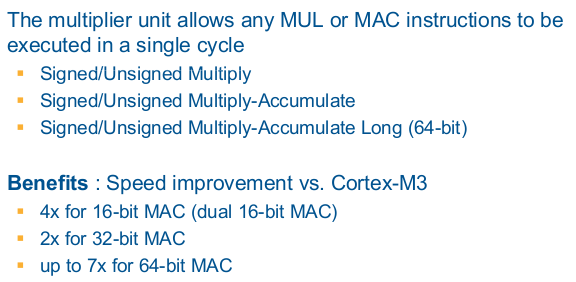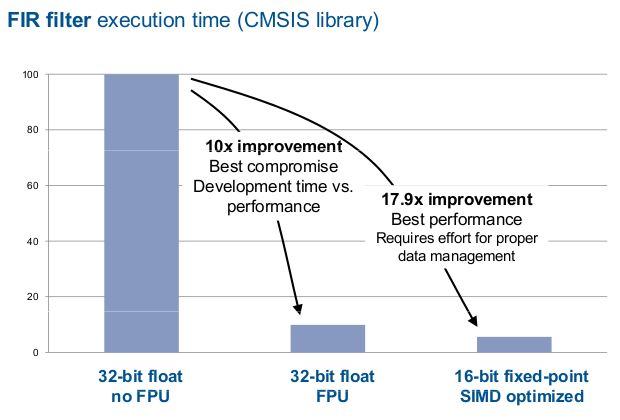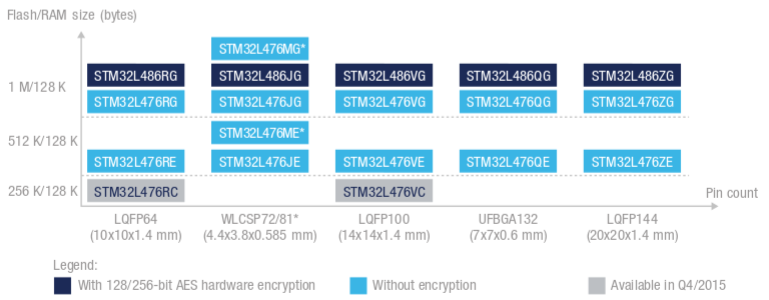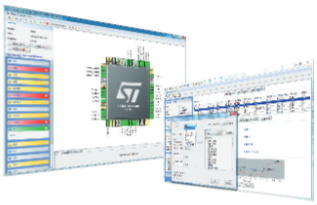


Home Page
INDEX
- STM32L4xx official page is here
- Introduction
- Excellence in Ultra-Low-Power with heightened Performance
- FPU - Floating point benefits
- DSP - benefits
- Portfolio
- Tutorial
- Some interesting documentations and application notes
- Software Tools
- Evaluation
Board
- Brochure & Presentation
- What is Cortex M4
- Glossary
INTRODUCTION
ST has built a new architecture to reach best-in-class ultra-low-power figures thanks to its high flexibility.
STM32L4 MCUs have scored 123 (world record) in the standardized EEMBC™ ULPBench® tests that compare the efficiency of ultra-low-power microcontrollers.
Moreover, the STM32L4 series shatters performance limits in the ultra-low-power world.
It delivers 100 DMIPS based on its ARM® Cortex®-M4 core with FPU and ST ART Accelerator™ at 80 MHz.
STM32L4 microcontrollers offer dynamic voltage scaling to balance power consumption with processing demand, low-power peripherals (LP UART, LP timers) available in Stop mode, safety and security features, smart and numerous peripherals, advanced and low-power analog peripherals such as op amps, comparators, LCD, 12-bit DACs and 16-bit ADCs (hardware oversampling).
The series is available in 2 different lines: STM32L476 (USB, LCD) and STM32L486 (USB, LCD, AES).
To simplify migration and give you all the flexibility you need, the STM32L4 is pin-to-pin compatible with the different STM32 series and opens the door to the full STM32 ecosystem.
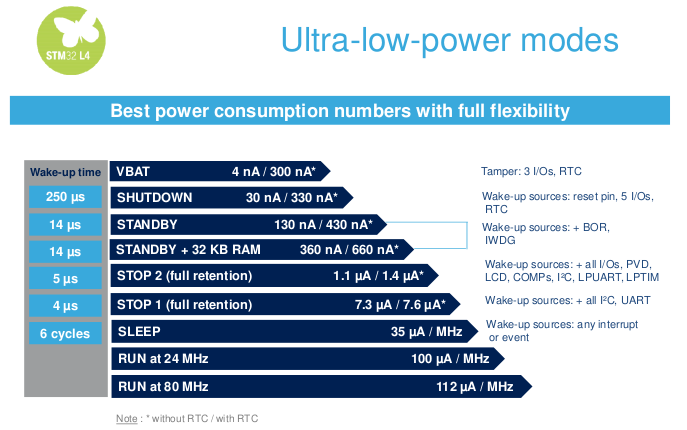


STM32L4 MCUs have scored 123 (world record) in the standardized EEMBC™ ULPBench® tests that compare the efficiency of ultra-low-power microcontrollers.
Moreover, the STM32L4 series shatters performance limits in the ultra-low-power world.
It delivers 100 DMIPS based on its ARM® Cortex®-M4 core with FPU and ST ART Accelerator™ at 80 MHz.
STM32L4 microcontrollers offer dynamic voltage scaling to balance power consumption with processing demand, low-power peripherals (LP UART, LP timers) available in Stop mode, safety and security features, smart and numerous peripherals, advanced and low-power analog peripherals such as op amps, comparators, LCD, 12-bit DACs and 16-bit ADCs (hardware oversampling).
The series is available in 2 different lines: STM32L476 (USB, LCD) and STM32L486 (USB, LCD, AES).
To simplify migration and give you all the flexibility you need, the STM32L4 is pin-to-pin compatible with the different STM32 series and opens the door to the full STM32 ecosystem.



Tutorial
- Up to now (March 2016) there is a problem on the SW that CubeMX generate for STM32L4xx family. See here.
- Become an STM32L4 expert with STM online training
- VIDEO - Getting Started with STM32L476 Discovery
- Migrating from STM32L1 series to STM32L4 series microcontrollers is here
- STM32-Discovery example, topics: CUBE, RTC, Blue Button and LEDs
- STM32L4 trainingPrague3d (Jan.2016 STM Prague)
ATTENTION
At the moment, the STM32L4_trainingPrague3d is only to SILICA customers.
If you are SILICA customer send me an email and ask me:
STM32L4_trainingPrague3d
please specify also your City, Country and your contact in SILICA.
If you are STM customer please contact directly your local office of STM.
- STM32L4 Tips and Tricks
ATTENTION
At the moment, the STM32L4 Tips and Tricks is only to SILICA customers.
If you are SILICA customer send me an email and ask me:
STM32L4 Tips and TricksIf you are STM customer please contact directly your local office of STM.
please specify also your City, Country and your contact in SILICA.
- STM32L4 trainingPargue1d (Dic.2015 STM Prague 1d - 384Mbyte)
ATTENTION
At the moment, the STM32L4_trainingPrague1d is only to SILICA customers.
If you are SILICA customer send me an email and ask me:
STM32L4_trainingPrague1dIf you are STM customer please contact directly your local office of STM.
please specify also your City, Country and your contact in SILICA.
- STM32L4_training (Nov.2015 STM Italy - 487Mbyte)
ATTENTION
At the moment, the STM32L4_training is only to SILICA customers.
If you are SILICA customer send me an email and ask me:
STM32L4_trainingIf you are STM customer please contact directly your local office of STM.
please specify also your City, Country and your contact in SILICA.
- Click Here for: see all STM32 examples
UP
UP
-
Some interesting documentations and application notes
Some interesting documentations and application notes
- Optimizing power and performances with STM32L4 series microcontrollers (AN4746)
- STM32L4 ultra-low-power features overview (AN4621)
- A complete set of training modules
that provide a technical description of all the STM32L4 features
including peripherals and development tools organized into specific
sections: system, memory, security, analog, peripherals, watchdog and
timers and ecosystem.
-
NUCLEO-L476RG
-
STM32L4-Discovery
-
STM32L476G-EVAL
NUCLEO-L476RG
STM32 Nucleo-64 development board with STM32L476RGT6 MCU, supports Arduino and ST morpho connectivity.
The STM32 Nucleo board provides an affordable and flexible way for users to try out new ideas and build prototypes with any STM32 microcontroller line, choosing from the various combinations of performance, power consumption and features.
The Arduino™ connectivity support and ST Morpho headers make it easy to expand the functionality of the STM32 Nucleo open development platform with a wide choice of specialized shields.
An ST-LINK/V2-1 is integrated on the board, as embedded in-circuit debugger and programmer for the STM32 MCU and USB Virtual Com Port bridge.
The STM32 Nucleo board comes with the STM32 comprehensive software HAL library together with various packaged software examples, as well as direct access to mbed online resources.

The STM32 Nucleo board provides an affordable and flexible way for users to try out new ideas and build prototypes with any STM32 microcontroller line, choosing from the various combinations of performance, power consumption and features.
The Arduino™ connectivity support and ST Morpho headers make it easy to expand the functionality of the STM32 Nucleo open development platform with a wide choice of specialized shields.
An ST-LINK/V2-1 is integrated on the board, as embedded in-circuit debugger and programmer for the STM32 MCU and USB Virtual Com Port bridge.
The STM32 Nucleo board comes with the STM32 comprehensive software HAL library together with various packaged software examples, as well as direct access to mbed online resources.

-
STM32L4-Discovery
32L476GDISCOVERY - Discovery kit with STM32L476VG MCU
The 32L476GDISCOVERY helps users to develop and share applications with the STM32L4 ultra-low-power microcontrollers.
The Discovery kit combines STM32L476 features with LCD, LEDs, audio DAC, sensors (microphone, 3 axis gyroscope, 6 axis compass), joystick, USB OTG, Quad-SPI Flash memory, expansion and probing connectivity.
It includes an embedded Ammeter which measures the MCU consumption in low power modes.
An ST-LINK/V2-1 is integrated on the board, as embedded in-circuit debugger and programmer for the STM32 MCU and USB Virtual Com Port bridge.
An external board can be connected thanks to extension and probing connectors.
VIDEO - Getting Started with STM32L476 Discovery

The 32L476GDISCOVERY helps users to develop and share applications with the STM32L4 ultra-low-power microcontrollers.
The Discovery kit combines STM32L476 features with LCD, LEDs, audio DAC, sensors (microphone, 3 axis gyroscope, 6 axis compass), joystick, USB OTG, Quad-SPI Flash memory, expansion and probing connectivity.
It includes an embedded Ammeter which measures the MCU consumption in low power modes.
An ST-LINK/V2-1 is integrated on the board, as embedded in-circuit debugger and programmer for the STM32 MCU and USB Virtual Com Port bridge.
An external board can be connected thanks to extension and probing connectors.
VIDEO - Getting Started with STM32L476 Discovery

-
STM32L476G-EVAL
STM32L476G-EVAL, Evaluation board with STM32L476ZG MCU
The STM32L476G-EVAL evaluation board has been designed as a complete demonstration and development platform for STMicroelectronics ARM® Cortex®-M4 core-based STM32L476ZGT6 microcontroller with three I2C, three SPI, six USART, CAN, SWPMI, two SAI, 12bit ADC, 12bit DAC, LCD driver, internal 128 Kbyte SRAM and 1 Mbyte Flash memory, Quad SPI, Touch sensing, USB OTG FS, LCD controller, FMC, JTAG debugging support.
The full range of hardware features on the board can be used to evaluate all peripherals (USB OTG FS, USART, digital microphones, 12bits ADC and DAC, dot-matrix TFT LCD, LCD glass, IrDA, LDR, SRAM, Nor Flash, Quad SPI memory, MicroSD card, Sigma-delta modulators, Smartcard with SWP, CAN, I2C EEPROM, RF-EEPROM) and develop user’s applications.
Extension headers make it possible to easily connect a daughterboard or wrapping board for a specific application.
An ST-LINK/V2-1 is integrated on the board, as embedded in-circuit debugger and programmer for the STM32 MCU and USB Virtual Com Port bridge.
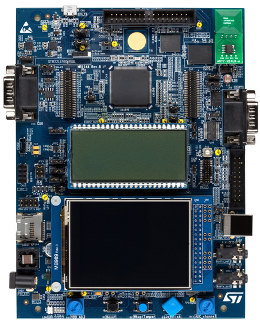
The STM32L476G-EVAL evaluation board has been designed as a complete demonstration and development platform for STMicroelectronics ARM® Cortex®-M4 core-based STM32L476ZGT6 microcontroller with three I2C, three SPI, six USART, CAN, SWPMI, two SAI, 12bit ADC, 12bit DAC, LCD driver, internal 128 Kbyte SRAM and 1 Mbyte Flash memory, Quad SPI, Touch sensing, USB OTG FS, LCD controller, FMC, JTAG debugging support.
The full range of hardware features on the board can be used to evaluate all peripherals (USB OTG FS, USART, digital microphones, 12bits ADC and DAC, dot-matrix TFT LCD, LCD glass, IrDA, LDR, SRAM, Nor Flash, Quad SPI memory, MicroSD card, Sigma-delta modulators, Smartcard with SWP, CAN, I2C EEPROM, RF-EEPROM) and develop user’s applications.
Extension headers make it possible to easily connect a daughterboard or wrapping board for a specific application.
An ST-LINK/V2-1 is integrated on the board, as embedded in-circuit debugger and programmer for the STM32 MCU and USB Virtual Com Port bridge.

UP
What is Cortex M4
The Cortex-M family is an ideal solution for ranges of compatible, easy to use embedded devices such as microcontrollers (MCU) where different cost, power and performance considerations must be made. Each processor delivers an optimal trade-off for a broad embedded application range.

Cortex-M family processors are all binary upwards compatible, enabling software reuse and a seamless progression from one Cortex-M processor to another.

The ARM Cortex™-M4 processor is the latest embedded processor by ARM specifically developed to address digital signal control markets that demand an efficient, easy-to-use blend of control and signal processing capabilities.
The combination of high-efficiency signal processing functionality with the low-power, low cost and ease-of-use benefits of the Cortex-M family of processors is designed to satisfy the emerging category of flexible solutions specifically targeting the motor control, automotive, power management, embedded audio and industrial automation markets.
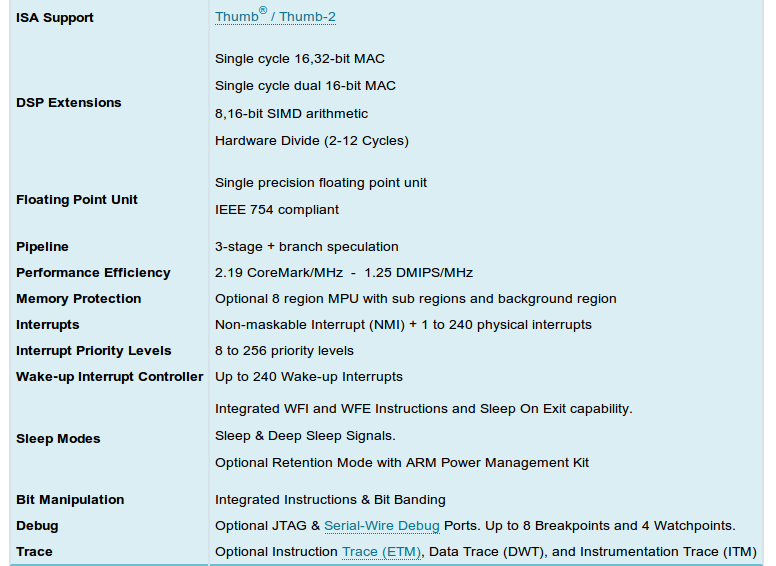
The Cortex-M4 processor has been designed with a large variety of highly efficient signal processing features applicable to digital signal control markets. The Cortex-M4 processor features extended single-cycle multiply-accumulate (MAC) instructions, optimized SIMD arithmetic, saturating arithmetic instructions and an optional single precision Floating Point Unit (FPU).
These features build upon the innovative technology that characterizes the ARM Cortex-M series processors.



UP
UP
What is Cortex M4
The Cortex-M family is an ideal solution for ranges of compatible, easy to use embedded devices such as microcontrollers (MCU) where different cost, power and performance considerations must be made. Each processor delivers an optimal trade-off for a broad embedded application range.

Cortex-M family processors are all binary upwards compatible, enabling software reuse and a seamless progression from one Cortex-M processor to another.

The ARM Cortex™-M4 processor is the latest embedded processor by ARM specifically developed to address digital signal control markets that demand an efficient, easy-to-use blend of control and signal processing capabilities.
The combination of high-efficiency signal processing functionality with the low-power, low cost and ease-of-use benefits of the Cortex-M family of processors is designed to satisfy the emerging category of flexible solutions specifically targeting the motor control, automotive, power management, embedded audio and industrial automation markets.

The Cortex-M4 processor has been designed with a large variety of highly efficient signal processing features applicable to digital signal control markets. The Cortex-M4 processor features extended single-cycle multiply-accumulate (MAC) instructions, optimized SIMD arithmetic, saturating arithmetic instructions and an optional single precision Floating Point Unit (FPU).
These features build upon the innovative technology that characterizes the ARM Cortex-M series processors.



UP
UP


